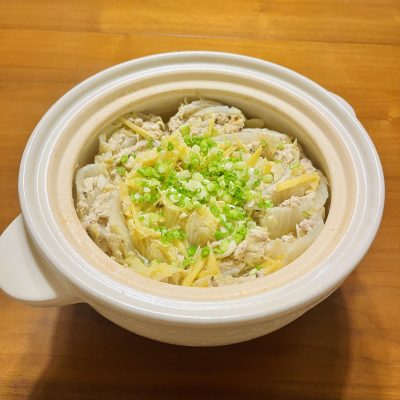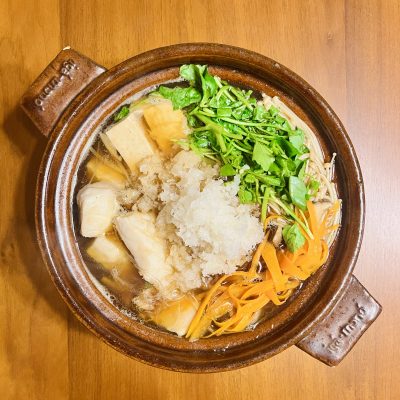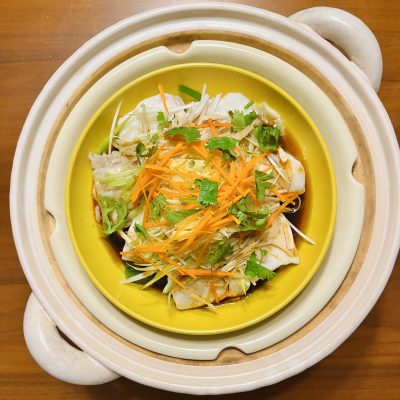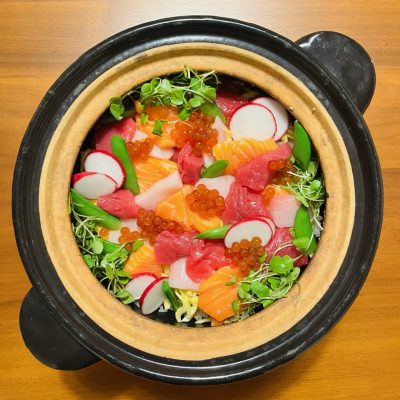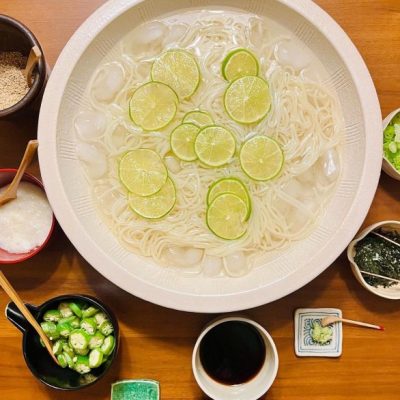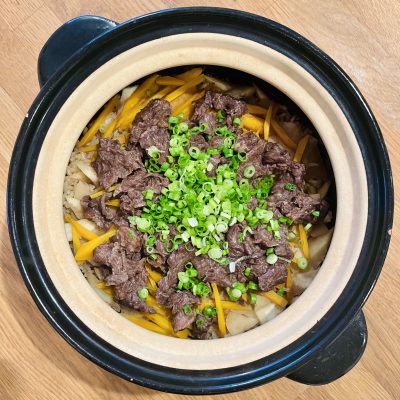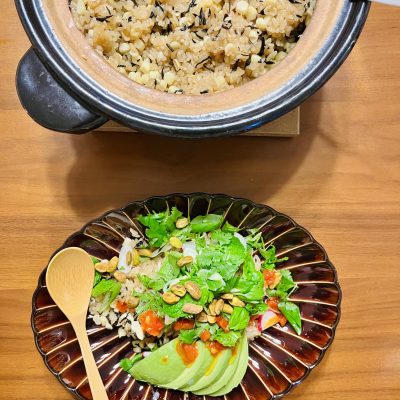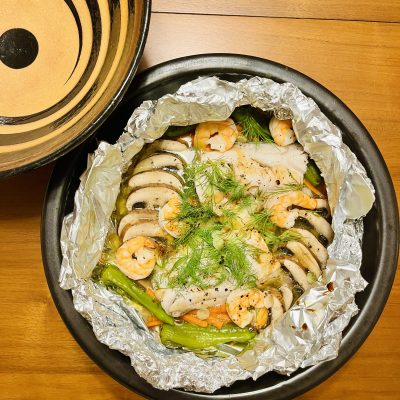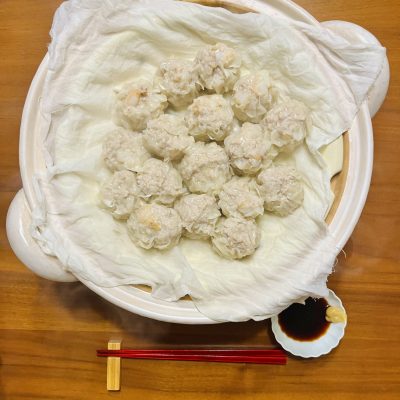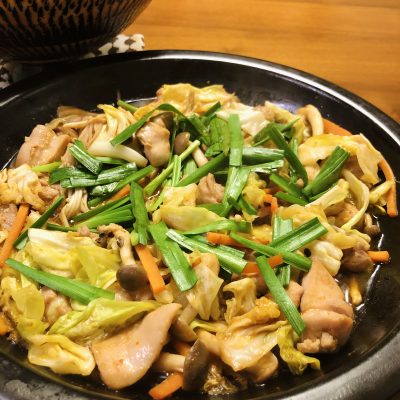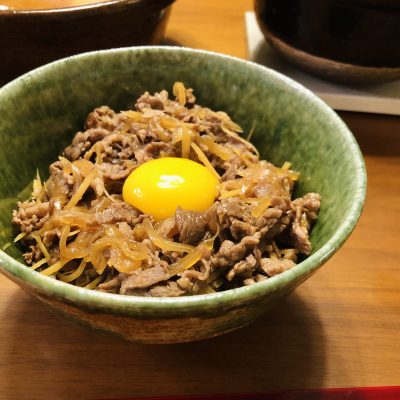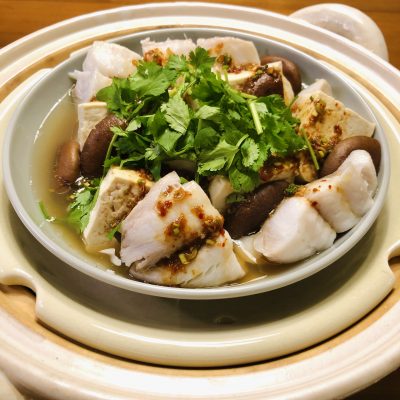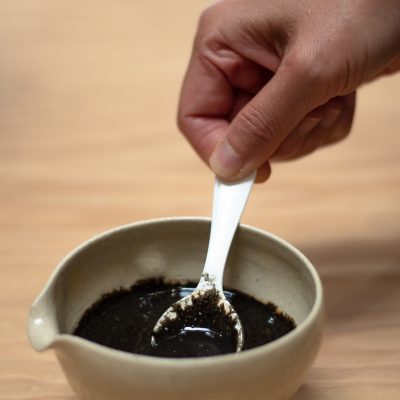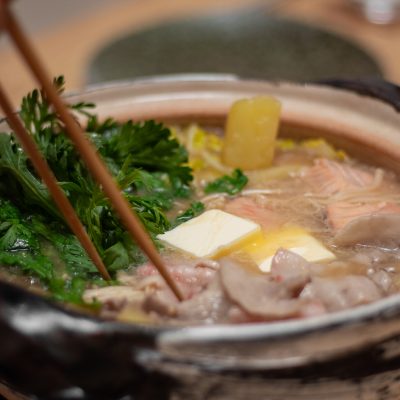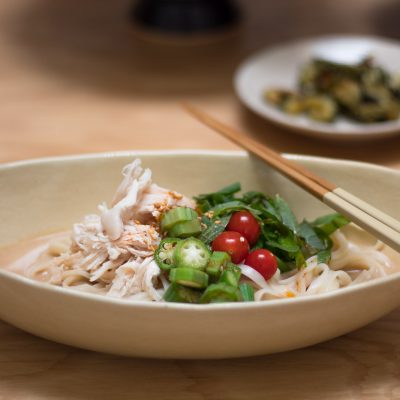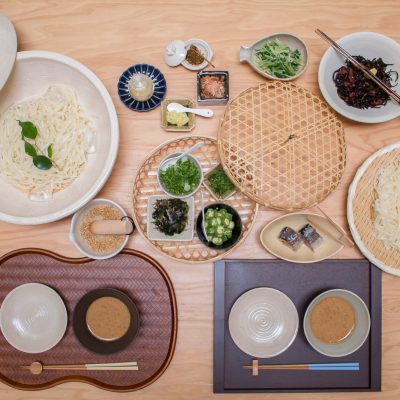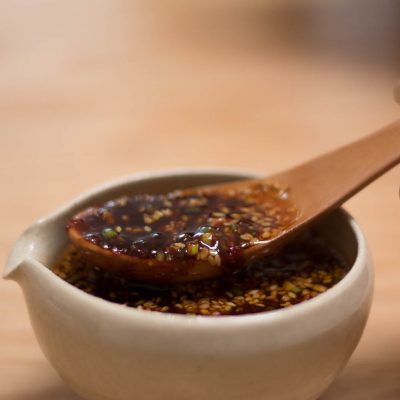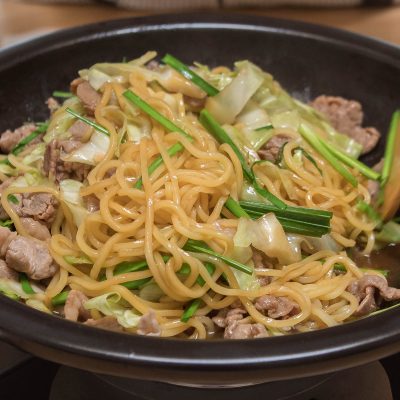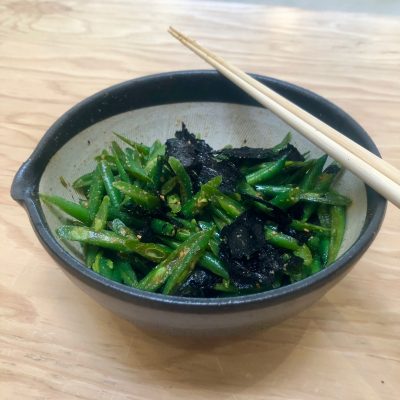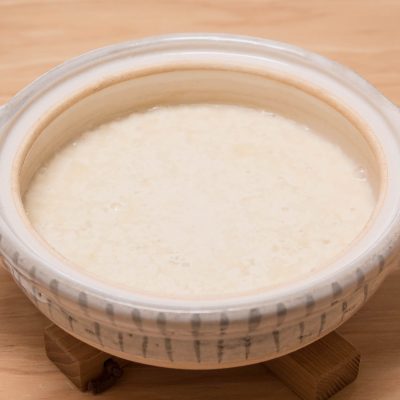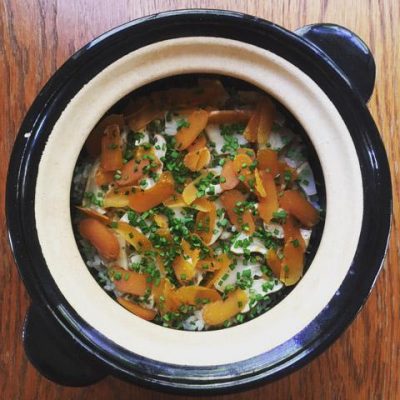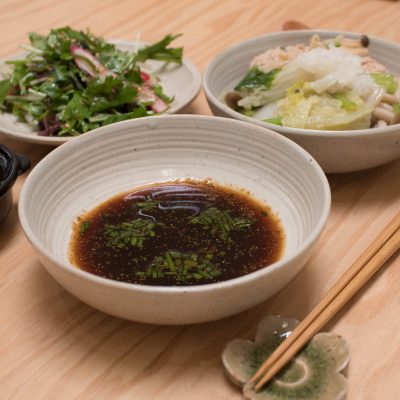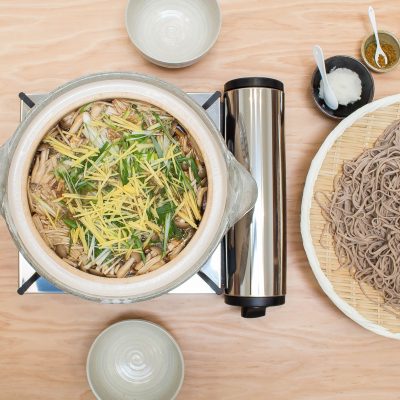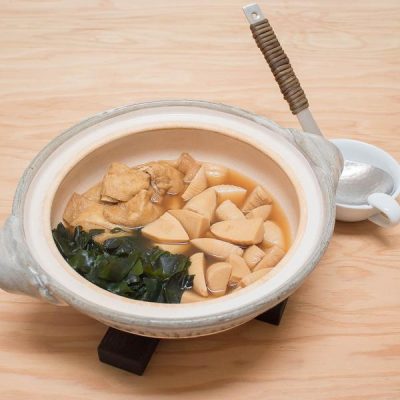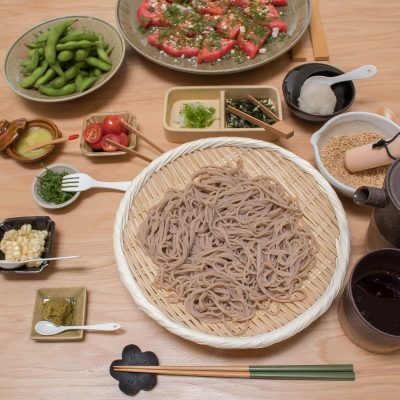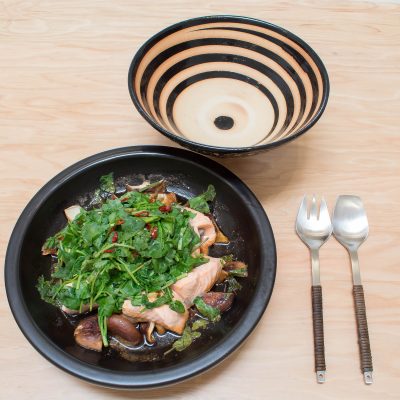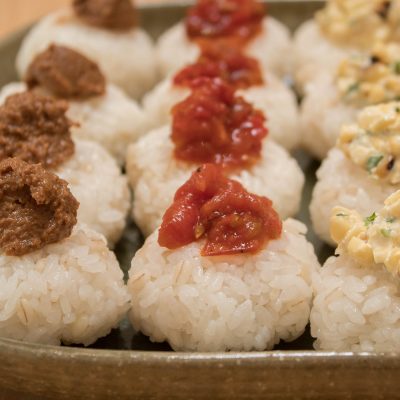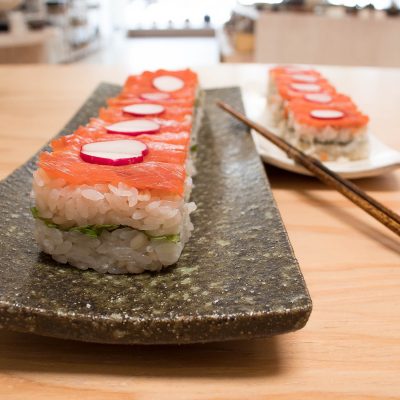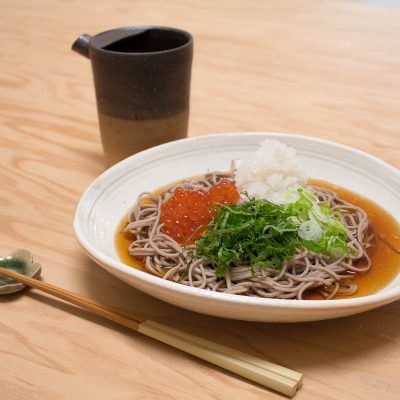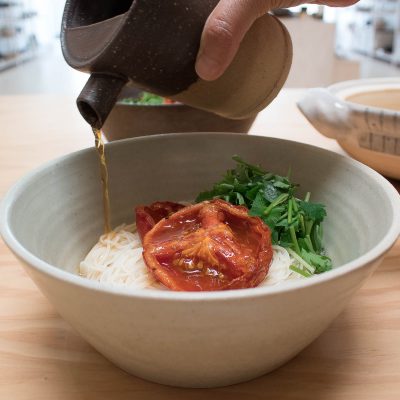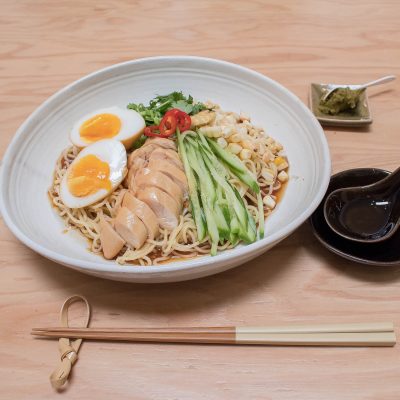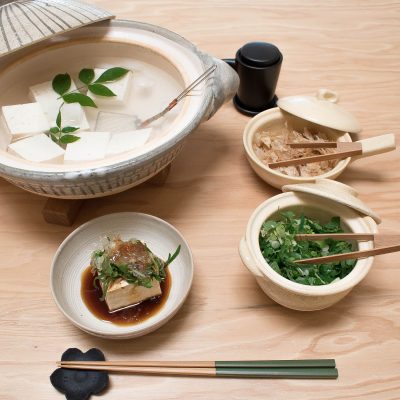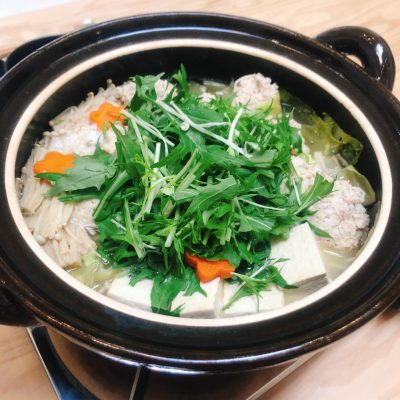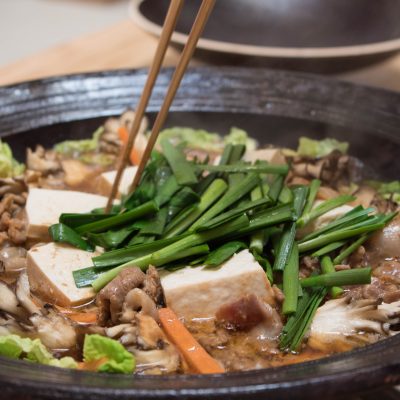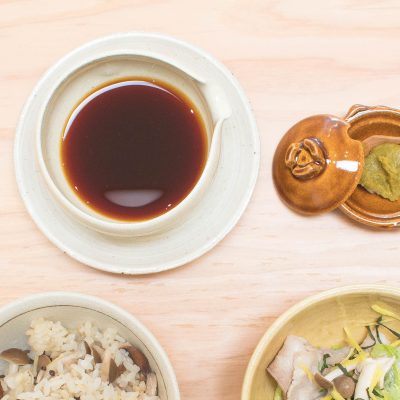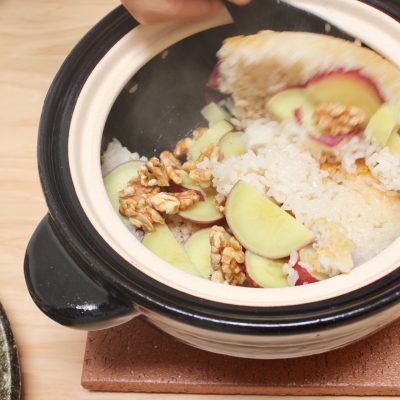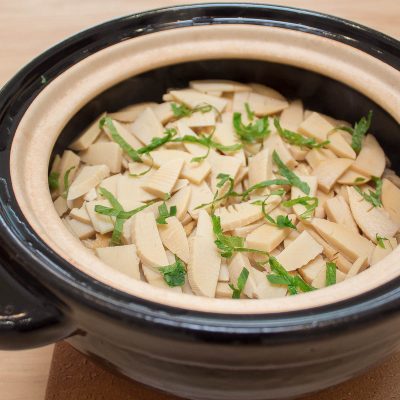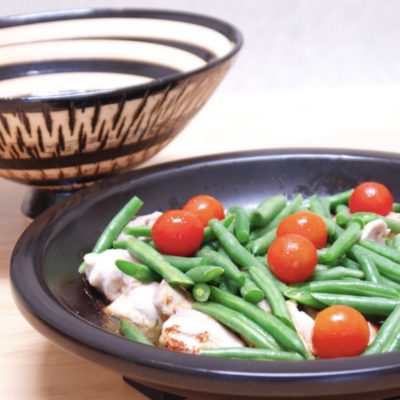I have introduced Ume-Shu (Japanese plum liqueur) recipe in this site, and this has been very popular. So, I wanted to introduced more ume recipes and here they are! They are non-alcoholic condiments/ drink base so can be enjoyed by anyone. During the ume season (late April to early June), I get so excited and want to make different ume drinks/ condiments. All these three ume condiments are really amazing, as the ume gives the very special aromatic and very pleasant soft tart flavors/ aromas to any dish/ drinks you make with it. They are really versatile and I enjoy them all year round.
Tag Archives: Soy sauce
Chicken & Tofu Mille Feuille Nabe
Here is a new variation to my “mille feuille” nabe recipes and this is a total keeper. It’s napa cabbage with ground chicken and tofu filling and tastes so rich and soothing. I season the dish with a Vegetable Dashi bag by simply tearing the bag and sprinkle the contents over the dish before cooking. This vegetable dashi bag is so convenient and the result is simply fantastic. The dish is packed with umami and already so tasty on its own, but I like to drizzle a small amount of soy sauce or a dab of Yuzu-Kosho.
Halibut & Daikon Hot Pot
Here’s my healthy seafood hot pot, Halibut Mizore Nabe – Halibut (or your choice of fish) is quickly simmered with vegetables and finished with a generous amount of grated daikon on top. With the addition of the glass noodles, this dish makes a very satisfying one pot donabe meal.
Chinese-Style Steamed Fish
This colorful treat is an easy one-pot dish with a lot of flavors. I like to use halibut for the rich tender texture for this dish, but you can also make it with other kinds of fish such as black cod, sea bass, salmon, etc. The fish is topped on the top parts of green onions and sprinkled with garlic slices to steam for beautiful aromas. The fish is also dusted with some katakuriko (potato starch) so this way the fish can absorb more flavors and retains moisture better, but you can cook without katakuriko, too. The sizzling sound and aroma of the smoking sesame oil when it’s poured over the fish stimulate your appetite so much. With the umami-rich sauce and aromatic toppings, this dish can become a healthy and satisfying main course.
I got the super fresh Alaskan halibut from Kai Gourmet again! They have the sustainably sourced premium sashimi quality seafood and deliver to your door, anywhere in the US. I can order by midnight and get my order overnight. I have been a huge fan of Kai Gourmet for many years.
I partnered with Kai Gourmet again and have a promo code for you. Visit their website and enter the below code to receive 10% discount for your order (full priced items only). Hope you will try their seafood!
Website: https://kaigourmet.com/
Promo Code: ToiroKai10
Seafood Chirashi Sushi
My donabe Seafood Chirashi Sushi (Seafood scattered over sushi rice) is really simple to make, and it always comes out so festive and delicious! Double-lid Donabe Rice Cooker, Kamado-san can make the perfectly shiny sushi rice, and you just need to decorate the rice with your choice of sashimi quality seafood and vegetables. That’s it. I normally buy extra amount of seafood so I can serve any remainder on the side.
For those who want to know where I buy my seafood from, I love Kai Gourmet! They have the sustainably sourced premium sashimi quality seafood and deliver to your door, anywhere in the US. I can order by midnight and get my order overnight. I have been a huge fan of Kai Gourmet for many years.
This time, I partnered with Kai Gourmet and have a promo code for you. Visit their website and enter the below code to receive 10% discount for your order (full priced items only). Hope you will try their seafood!
Website: https://kaigourmet.com/
Promo Code: ToiroKai10
Cold Somen Noodle with Soy Dipping Sauce
Perfect for a hot summer day. Here’s one of my most basic cold noodle dishes which I never get tired of all my life. Donabe can make a perfect serving vessel, and it also makes a wonderful presentation, along with a variety of toppings.
For the dipping sauce, I have this staple soy-based sauce, Kaeshi, always in handy. Kaeshi is a multi-purpose sauce I use for so many things. I pour over noodle by mixing with water/ dashi, chicken, fish, salad, etc.
Beef Rice
Juicy donabe Beef Rice for your stamina. I used a block of American Wagyu hanger steak and thinly sliced by hand. By marinating the beef for a short time with sake, soy sauce and black sugar, the meat comes out so tender like you braised it! I also used some smoked soy sauce to complement the bold flavor but you can use only regular soy sauce, too. Donabe makes this dish so complete in flavor and texture, and it was just so delicious that I ate almost half of the pot. Happy Donabe Life!
Corn & Hijiki Rice with Olive Oil
This donabe dish is a variation of my other corn rice recipes and has been a big hit! This is 100% vegan and its flavor is really rich with corn, and fresh and aromatic with the addition of the extra virgin olive oil and mixed herbs. This dish makes a great one plate meal and tastes great at a warm or room temperature. Happy Donabe Life!
Baked Foil-Wrapped Seafood
Foil-baked seafood is such an easy-prepping and delicious dish. It also requires basically no cleaning of the cooking equipment. I always make it in my tagine-style donabe , Fukkura-san, as not only it distributes the heat perfectly without getting the bottom burned quickly but also it makes a very nice presentation at the table. The dish is flavored simply with sake, butter, and a drizzle of soy sauce and it’s so perfect! When the foil is gently cut open and the dish is revealed, it brings so much excitement, and also the aroma of butter-sake infused ingredients is so irresistible. Smoked soy sauce makes the dish so special but a regular soy sauce can work just fine, too.
Shrimp Pork Shumai
Nothing is more appetizing than the steaming hot shumai dumplings. With the donabe steamer, Mushi Nabe, you can quickly steam them and serve right out of it at a table. Feel free to change the ratio of pork and shrimp. I slice the shrimp coarsely so the finished texture is really fantastic. It’s a very irresistible dish so I can easily eat more than 10 pieces in one meal! The dipping sauce is simple combo of soy sauce and rice vinegar, plus a dab of karashi (Japanese hot mustard) adds a great kick.
Sizzling Shoyu Chicken & Cabbage
Kei-chan is a very popular local dish from Gifu, Japan. In my past visits to Gifu, I was really fascinated by this homy chicken dish. The main ingredients are chicken and cabbage, and they are sit-fried together in either miso or soy-based sauce. I especially love the soy-based version, so I now have my own version and it’s so good. Because it’s stir-fried, tagine-style donabe works especially great with its flat skillet bottom. But, you can also improvise the dish with other types of donabe which can be heated empty.
Beef Bowl
Gyu-Don, or beef bowl, is one of the most popular rice bowl dishes in Japan. It’s basically soy-flavored and slightly sweet simmered thin beef slices over rice. Here in LA where I live now, unless I take a trip to a Japanese market, I can’t get very thinly sliced beef at a regular market like in Japan. So, I usually get a block of boneless beef short rib and hand-slice it very thinly myself. I actually find this hand-cut version better than the other. The meat is simmered with onion in donabe for about half an hour and the result is such tender and flavorful beef. Donabe can bring out all the umami flavors cooked in it and become quite magical.
Spicy Soy-Marinated Tuna Rice Bowl
When I get really fresh fish, I enjoy eating it straight as sashimi, or I also enjoy creating a quick one-bowl meal by topping it over rice. It never goes wrong. You can make it with sushi rice or just plain rice. I also like to quickly marinade the sashimi in soy-based sauce to top over the rice. It’s called Zuke-Don. Zuke means “marinade”, and Don is donburi rice bowl. Here’s my really tasty Spicy Zuke-Don with fresh tuna.
Steamed Black Cod with Soy-Negi Sauce
My large donabe steamer, Mushi Nabe, works so hard all year round. Among my favorite preparations with this donabe is a steamed fish dish. This is Steamed Black Cod with Soy-Negi Sauce. I layered black cod with tofu and shiitake mushrooms in a bowl and steamed in the donabe steamer, and poured this aromatic soy & scallion sauce (with a great kick with la-yu oil) over it to enjoy. This dish takes little effort and is really flavorful,and it also keeps your body so warm. Feel free to substitute with different kinds of fish.
Black Sesame Sauce
This is a very healthy and tasty all-purpose sauce, and made with all “black” ingredients. All you need to do is just whisk together black sesame paste, black sesame seeds, black vinegar, soy sauce, and black sugar. My regular way to use this sauce is to serve with simple steamed tofu and mushrooms. You can also enjoy it with steamed vegetables, fish, etc.
Miso Butter Hot Pot with Salmon and Pork
I’ve made this hot pot many times this season, both for myself and many other people. And, many of them asked me to share the recipe so they can make it home. The miso broth has two kinds of miso for complexity. The addition of butter at the end gives the beautiful depth in flavor.
Ishikari Nabe is originally a regional dish from Hokkaido (the northern island of Japan), and to me, the must “rule” to be called Ishikari Nabe is that the dish has to have salmon and potato in the miso broth. They taste so good together (especially with the butter added at the end)! That being said, the broth can go well with just about anything, so you can change around the ingredients to cook in it. When I cook for my vegan friends, I use kombu and shiitake dashi, and make it with tofu and different kinds of mushrooms (and no butter).
You can make the miso base (mixture of the miso, sake, mirin and soy sauce) in advance, and when it’s ready to serve, you can simply combine the miso base with dashi, and start cooking the ingredients in it at the table (or at in the kitchen stove and serve at the table).
For “shime” (finishing course), I love making ojiya (soupy porridge) in the remaining broth. Ramen is also great, too.
Smokey Shoyu Corn Hijiki Rice
This rice dish has been a big hit throughout this summer, and I made it many times. As long as you have nice sweet fresh corn, this dish can almost never fail. Corn and hijiki seaweed go so well together (I also like to make a salad dish featuring these two ingredients), and they blend in with the rice nicely.
The butter and Smoked Soy Sauce are added after the rice is made, so they keep the really fresh flavors. The aroma is quite irresistible. If you don’t have the Smoked Soy Sauce, you can use a regular soy sauce for a non-smokey version.
Salmon Roe & Grated Daikon Cold Udon
Here is another cold noodle dish with the classic topping combination of salmon roe and grated daikon (“ikura oroshi” – the other dish I posted with the combo is with cold soba and you can find a link here). This is served over udon and the broth is rich in dashi with a refreshing accent with yuzu juice and rice vinegar. The broth is so soothing, so you can drink it up, too.
You can make your own variations with different toppings such as chicken tender, roasted vegetables, wakame, eggs, or anything you like. I also like it with grilled eggplant!
Cold Udon with Sesame Soymilk Sauce
This cold udon dish has a very tasty and refreshing broth made of soymilk and golden sesame paste. It’s poured over the udon and really makes the dish so special. For this broth, I use my Dashi Shoyu (rich dashi-flavored soy sauce) as a base seasoning. This Dashi Shoyu is extremely versatile and can be used it on its own as a seasoning for sautéed dish or can be mixed other liquid (can be just water) to make a broth or a sauce. So, I keep my Dashi Shoyu in my fridge always. Once you make a batch of it, you can keep it for up to a month or even longer.
The toppings can be basically anything you like, so you can be creative.
Cold Udon with Golden Sesame Dipping Sauce
I love cold udon as much as cold somen especially in the summertime. It would depend on the type of udon, but cold udon usually has the nice bouncy texture and it’s also smooth when it goes through the throat. Serving cold udon in a donabe with some ice cubes not only makes a beautiful presentation, but with the porous donabe body gets insulated, it can keep the noodle very cold for extended time.
For this dish, I served the same rich sesame sauce which I introduced in the cold somen recipe. This is a versatile sauce and has nice nutty flavor with natural sweetness coming from the combination of the Golden Sesame Paste and Saikyo Miso.
Enjoy with your choice of toppings. I also like it with canned saba (Japanese mackerel). I usually bring back a very nice kind from Japan.
Nao-Jan (Naoko’s Yakiniku Sauce)
This is my regular tare (dipping sauce) for yakiniku (grilled meat), or anything grilled including seafood and vegetables. It’s rich in flavors with two kinds of soy sauce (or you can make with one kind), Hatcho miso, ginger, garlic, etc. And the addition of the pure daidai citrus juice gives the beautiful aromatic nuance. Great accompaniment for anything I cook with my Iga-yaki grills.
Oyster Sauce Flavored Steam-Fry Pork Yakisoba Noodle
Yakisoba (stir-fry noodles) is such a casual tasty dish which almost everybody in Japan loves. While there are so many variations of yakisoba, my all time favorite is the simple oyster sauce flavor with pork and cabbage. This yakisoba makes me feel nostalgic, as it’s similar to what my mom used to make for a quick lunch when I was a child. With the tagine-style donabe, Fukkura-san, the ingredients are steam-fried and the noodles have such a nice bouncy texture, while the meat and cabbage get lightly caramelized. Instead of typical karashi (Japanese hot mustard), I like serving this dish with Kanzuri.
As a variation, you can substitute soy sauce with Smoked Soy Sauce for a nice smokey and robust nuance.
Green Beans and Nori Salad
This quick salad dish is very easy to make, and I love how the nori brings a beautiful aroma to this dish. The roasted and ground sesame seeds, yuzu juice, and sesame oil adds extra layers of flavor, and go well with the tender green beans steamed in Mushi Nabe. You can substitute the golden sesame seeds/ golden sesame oil with black sesame seeds/ black sesame oil for a variation. The tamari soy sauce not only gives the rich umami to the dish, but makes the dish friendly for those on a gluten-free diet.
Soba Noodle with Green Onion and Shiitake Mushroom
Soba noodle is one of the most beloved traditional Japanese foods in Japan. Many people enjoy soba dishes for lunch, and there are soba restaurants (many are hand-made) and stands everywhere in Japan. At home, soba makes a very popular meal. This is my quick soba noodle dish I love and make all the time for lunch, and I change the toppings according to what I have in my fridge or pantry. Sometimes, I serve with just mushrooms, wakame seaweed, or even completely plain with a dash of yuzu citrus zest. With the porous body of the donabe, I like that the broth stays hot until the end of the meal.
Homemade Tofu
Authentic fresh tofu can be made at home very easily, once you have a donabe and high quality soymilk. All you need to do is to heat soymilk, stir in nigari liquid, turn off the heat, and rest until the mixture sets to become tofu. Iga-yaki donabe is perfect for fresh tofu making, because the porous body achieves the gentle and even heat distribution. It also cools down very slowly after turning off the heat, so the tofu can set to ideal stage during the resting time. The fresh warm tofu right out of donabe is simply a joy and I always have my first few tastes without any seasonings or condiments. It’s so fluffy, delicate, and pure. Then, I enjoy it with different toppings. Sometimes simply with shaved katsuobushi (shaved dried bonito flakes) and soy sauce, or wasabi, sea salt (such as moshio sea salt), and sesame oil. Ponzu is great, too.
Premium quality Banrai Soymilk and Banrai Nigari Liquid are both available at our shop. So, hope you give it a try. You can make a full-size sukui tofu to share or a small individual-size tofu in a mini-size donabe for everyday breakfast.
The recipe introduced in this page is calling for 1-liter soymilk. For the half amount, you can use a small-size classic-style donabe (approx. 0.8-qt/ 800 ml size). The photos below are made with small-size Rikyu-Tokusa donabe.
For an idividual-size silky tofu making method, please see Banrai Soymilk and Banrai Nigari Liquid product page.
Bottarga and Matsutake Rice
When I’m lucky enough to have these special ingredients at the same time, I love making this dish. The earthy perfumy aroma of matsutake mushroom is so elegant and there is nothing equivalent to it. The umami-packed and slightly chewy character of karasumi (cured mullet roe, a Japanese delicacy, and it’s also a famous Italian ingredient, called bottarga in Italian.) You can substitute matsutake mushroom with a different kind of mushroom such as shimeji (although the aroma is very different, it’s still tasty) when matsutake is out of season. For karasumi, instead of slicing it, you can grate it to mix in the rice, too.
The dish shown in this photo is made in 1 rice-cup size Kamado-san.
Sansho Ponzu Sauce
Combination of soy sauce, daidai citrus and sansho powder (did you know sansho also belongs to citrus family?) create such refreshing bright aroma and kick in this quick dipping sauce. Adjust the amount of sansho powder according to your taste (or tolerance to its numbing heat). Originally introduced to serve with Shiso Chicken Meatball and Grated Daikon Hot Pot, this sauce is good for any hot pot dishes, or as a dipping sauce for gyoza dumplings.
Mabo Tofu
This is a Japanese version of popular Chinese dish (mapo tofu), which is a spicy stew of tofu and ground pork. My Mabo Tofu is seasoned with miso, and it gives nice rich flavor to the dish. For the spicy heat and extra umami, tobanjan (Chinese chili bean paste) is usually an essential ingredient for this dish. But, I often substitute it with Kanzuri, and it works great, too! You can make this dish with any classic-style donabe, or Mushi Nabe without the steam grate. I used my Bistro Mushi Nabe in the photos in this recipe.
Soba Noodle with Hot Mushroom Dipping Broth
I love making this dish especially when I am feeling a little weak and need something gentle for my stomach. Once you simmer mushrooms in a rich dashi-based broth, pour it into serving bowls and dip cold noodles in it to enjoy. The mushrooms adds the nice savory flavors to the broth. And, I love to use a generous amount of thinly-sliced ginger for both flavor and helping my body stay warm after having the dish. It’s so soothing and you can keep eating more and more. This dish is also nice to serve for a larger group. You can also change around the ingredients to cook in the broth for fun. For a vegan version, you can make with kombu dashi or vegetable dashi instead of kombu & bonito dashi.
Shio-koji Salmon over Butter Sweet Potatoes
This dish is something I like to whip up especially on a busy day. While marinating the salmon in shio-koji, I I can prepare all the other ingredients, then just pile them up and let the donabe do all the work. I love the slightly caramelized sweet potato in the bottom, while the salmon is perfectly cooked medium-rare (or you can cook it longer if you like the salmon to be well-done).
Simmered Bamboo Shoots in Dashi Broth
This is a very popular traditional Japanese dish in the spring, when fresh bamboo shoots and wakame seaweed are in the height of season. Bamboo brings sweet and tender characters, and the wakame is rich in mineral flavors. But, even if you can’t get such fresh ingredients in the season, with the increased availability and quality of pre-cooked bamboo and dried wakame, you can enjoy this dish all year round. I like to top it with a generous amount of shaved katsuobushi, as it gives extra rich flavor and makes the dish even more satisfying.
Cold Soba with Black Vinegar Dipping Sauce
Zaru Soba (cold soba with dipping sauce) has been a traditional fast food since Edo Period (1,603 – 1868) in Japan. From kids to elders, people in any social class can enjoy the fresh and smooth soba by quickly dipping in a sauce. While it’s a very popular quick dish for lunch, you can also find soba restaurants or posh izakaya establishments that serve soba as a final course after various small dishes to savor. I remember my late father ate soba for lunch 3 – 4 times a week because it was on of his very favorite foods. This version, instead of a typical soy sauce and mirin based sauce, I made it with an extra amount of dashi with a generous addition of brown rice black vinegar. The result is a very refreshing umami-packed dipping sauce, which you can even drink up (and it’s so good for you because of its high vinegar content).
Salmon, Shiitake and Watercress in Smokey Garlic Black Vinegar Sauce
With just three main ingredients (salmon, shiitake mushrooms, and watercress) and simple preparation, this sizzling dish makes a very satisfying meal. The garlic black vinegar flavor is further enhanced with smoked soy sauce, but if you don’t have it, you can make it with regular high quality soy sauce, too. Make sure to drink up any remaining sauce, or dip some freshly-cooked donabe rice, as it’s so tasty.
Smoky Shoyu-Flavored Corn & Bacon Rice
Here’s another version of my corn rice; this one has a big, bold flavor with the addition of rendered bacon, Smoked Soy Sauce, and butter. This is a great dish to serve at a summer party, too. When I made this dish at an outdoor BBQ dinner one day, everybody went crazy and it was gone so quickly! Corn is so sweet and savory at the same time, with its nice smokey and nutty flavor. Although this addition is highly recommended, if you would like to omit the 16 Multi Mixed Grains, you can reduce the amount of the dashi by a tablespoon or so.
Rice Balls with Three Kinds of Toppings (Summer Version)
At our 2018 Summer Festival at TOIRO, we made hundreds of onigiri (rice balls) with freshly made rice in our double-lid donabe rice cooker, Kamado-san, and served with these summer-theme toppings. We were so happy that many of our guests kept coming back to try more. The Walnut Miso includes Fig Vinegar so it has a refreshing and soft acidity. The Slow-Roasted Tomato is rich in umami and the Smoked Soy Sauce adds an extra layer of complexity. The Roasted Corn and Yuzu-Kosho Mayo has a beautiful, sweet corn flavor with an aromatic heat from the Yuzu-Kosho. These toppings are also great to serve with cold tofu or grilled meat. We hope you will try all three kinds. The amounts of these toppings in this recipe are more than enough to make the suggested servings, so you can keep any leftover for another use.
Pressed Smoked Salmon Sushi
Oshi-Zushi (pressed sushi) is always fun to make and is also tasty, especially when the rice is cooked in a Kamado-san. You can see in the photo how each grain retains its shape and is shiny after the sushi is pressed. The traditional wood sushi mold makes the process so easy and brings beautiful results. Here’s my quick oshi-zushi recipe, which can be made with something I normally stock in my fridge…smoked salmon, radish, and shiso leaves. If you don’t have access to shiso leaves, you can substitute with arugula or simply omit it. If you want to add Mochi Mugi barley to the rice, simply add a packet of Mochi Mugi to the rice and increase the water by 1/2 cup (120 ml) and cook together.
Cold Soba with Salmon Roe and Grated Daikon
This is another quick cold noodle recipe with toppings that don’t require any cooking. Ikura (salmon roe) and grated daikon are a classic combination in Japanese cuisine and they work great with the cold soba. When daikon is grated in a traditional onioroshi (bamboo daikon grater), as opposed to generic metal or plastic grater, the daikon retains a nice crunchy texture while retaining its moisture well. Besides, using onioroshi is kind of like a ritual to me. It’s fun and almost therapeutic to grate daikon with a onioroshi. Don’t forget to add a good amount of thinly-sliced shiso leaves, as it gives a beautiful aroma along with sliced green onions (but if you don’t have shiso, it will still work without it).
Cold Somen Noodle with Slow-Roasted Tomato
Here’s another variation of my recipe using slow-roasted tomatoes. After 4 – 5 hours in the oven, the tomatoes become so rich in umami flavors and very soft. So, I like to serve it very simply by topping them over the cold somen noodles and pouring a soy-flavored dashi broth over it. I like breaking the tomatoes with chopsticks and gently mix with the noodles as I eat, or you can coarsely chop the tomatoes before topping over the noodles, too.
The best thing is that both the tomatoes and broth can be prepared up to a few days in advance. So, once I make them for the next days, all I need to do is just boil the somen noodles and assemble them for a quick delicious meal.
Smoked Chinese-style Cold Noodle
Smoked toppings give such a tasty and unique upgrade to the popular summer dish. This dish has not only been a summer hit at my home, but I actually like to make it whenever I want all year round. The yuzu-flavored broth is so refreshing and creates a nice balance with the smoked toppings. For me, Yuzu-Kosho is an essential addition to add a nice kick to this dish, but it’s totally optional for those who prefer a less spicy flavor.
Chilled Tofu with Condiments
Hiyayakko is one of the most simple and beloved Japanese home dishes that is enjoyed all year round. It’s really about simple plain tofu, enjoyed with sliced scallion, shaved katsuobushi, and soy sauce or any condiments of your choice. In the summer time, to make the maximum “cold” effect by both taste and visual, I like to serve the tofu in ice bath in a donabe. Also in this way, you have a beautiful presentation and can even impress your guests. Medium-firm or soft tofu are recommended for hiyayakko, for the most pleasant texture.
Braised Chicken in Black Vinegar Sauce
The main ingredients of this dish are just chicken and shiitake mushrooms, yet this dish can make such a hearty meal. The meat is so succulent and falls off the bone easily even with chopsticks. The special black vinegar from Kyoto gives the umami-packed layer of flavors to this easy one-pot dish.
Chirashi Sushi with Soy-Marinated Tuna
This dish is very easy to make and always a crowd pleaser. Once you get a block of very fresh tuna, all you have to do is to make sushi rice, slice and marinade tuna, get other small components ready and just assemble. The marinating time of tuna should be just up to 15 – 20 minutes. If it’s marinated too long, it will start to “cook” the tuna and the color could get a bit too dark. I like to make the sushi rice by adding 16 Multi Mixed Grains for more complex flavor, texture, and beautiful color in the sushi rice, but you can make it without, too. Whenever I make this dish for friends, it disappears in a matter of moments!
Salt Butter Chanko Hot Pot
Japanese sumo wrestlers cook and eat chanko nabe at their stable every day. That’s the source of their strength. While chanko nabe refers to any types of hot pot eaten by sumo wrestlers, the most typical style is chicken as a main protein and cooked in chicken broth. It’s because chicken stands on two legs like human beings, so it is considered to bring good luck (in sumo, you lose if your hands touch the ground). Chanko nabe typically makes a very nutritious and balanced meal, as you cook a wide variety of healthy ingredients in one pot. The sumo wrestlers are big, because they eat so much of it every meal! In my version, I cook chicken meatballs and vegetables in simple salt-flavored chicken broth, and add butter cubes right before serving. The aroma is so irresistible and the flavor is superb. As a shime (finishing course), I suggest ramen noodles to cook in the remaining broth.
Spicy Pork Sesame Hot Pot
The marinade has such a rich flavor, and the creamy sesame paste makes it so aromatic. Once you have all the ingredients ready, all you need to do is just piling up the ingredients and build your excitement while waiting for the dish to cook. I love that I can taste so many different ingredients in this one dish, but you can always substitute or omit most of the ingredients as you like.
Make Your Own Shoyu Ramen Hot Pot
Making ramen is easy and fun, especially if you cook and serve as donabe hot pot right at the table. I like adding the chopped nira (garlic chives) to the ramen right before serving, but if you can’t find nira, you can substitute with thinly-sliced green onion and serve as a topping, instead. Enjoy with a couple of simple toppings or a make a platter of a wide selection of toppings to choose from for fun.
Soy-Flavored Simmered Ground Chicken
Very popular among Japanese people of all ages, this juicy simmered ground chicken is cooked in simple seasonings of soy sauce, sake, mirin, and sugar, and is typically served over plain rice. When I was a teenager, this dish, tori soboro gohan, used to be one of my favorite items in the bento my mom made me to take to school for lunch. My version has the accent of a generous amount of shredded ginger to stimulate your appetite. I like to serve it with a very soft-boiled egg (with runny egg yolk) over freshly cooked donabe rice. You can also enjoy it as a topping for steamed kabocha, asparagus, or tofu.
Quick Daidai Citrus Ponzu
This is a super simple ponzu, made by equal amount of Japanese daidai citrus (aromatic citrus, which is a type of orange) juice and high quality soy sauce. Great with tofu, grilled fish, etc.
Sweet Potato & Walnut Rice
Satsuma-imo (Japanese sweet potato) and roasted walnuts bring rich earth and sweet flavors to this dish.
Bamboo Shoot Rice
Spring is the high season for freshly foraged bamboo shoots and they taste really wonderful. They are crisp tender and full of sweet spring flavors. In Japan, people enjoy so many different kinds of bamboo dishes while the fresh shoots are in season. Bamboo shoot rice used to be my favorite bamboo dish my mom made when I was a child. This dish also tastes great at room temperature or even cold. If fresh bamboo shoots are not available, pre-cooked bamboo shoot can be found at Japanese grocery stores and they are sold all year round.
Japanese Beef & Potato Stew
This hearty beef and potato stew is such a popular Japanese home dish among people from little kids to elders. While there are countless variations, for my nikujaga, I like to caramelize the onion before adding other ingredients. The onion gives nice rich layer of umami flavor to the dish. Miso-shiru Nabe always makes the perfect caramelized onion without having to constantly sauté it. I also add a lot of thinly sliced gingers for the accent.
Steam-fry Shio-Koji Chicken, Green Beans, and Cherry Tomatoes
Chicken is quickly sautéed first, then steam-fried together with vegetables in Fukkura-san. Shio-koji marinated chicken has extra rich flavor with succulent texture. Drizzle some soy sauce and squeeze a generous amount of lemon as soon as the heat is turned off and the donabe is brought to the table, so they will sizzle with the residual heat in the skillet and becomes so aromatic.


